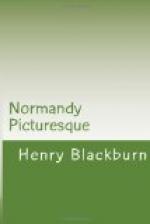But more interesting, perhaps, to the traveller who sees these things for the first time, more charming than the most exquisite Gothic lines, more fascinating than their quaint aspect, more attractive even than their colour or their age, are the associations connected with them; and the knowledge that they bear upon them the direct impress of the hands that built them centuries ago, and that every house is stamped, as it were, with the hall mark of individuality. The historian is nowhere so eloquent as when he can point to such examples as these. We may learn from them (as we did at Pont Audemer) much of the method of working in the 14th century, and, indeed, of the habits of the people, and the secret of their great success.
It is evident enough that in those old times when men were very ignorant, slavish, easily led, impulsive (childlike we might almost call them), everything they undertook like the building of a house, was a serious matter, a labour of love, and the work of many years; to be an architect and a builder was the aspiration of their boyhood, the natural growth of artistic instinct, guided by so much right as they could glean from their elders. With few books or rules, they worked out their designs for themselves, irrespective, it would seem, of time or cost. And why should they consider either the one or the other, when time was of no ‘marketable value,’ when the buildings were to last for ages; and when there were no such things as estimates in those days? Like the Moors in Spain, they did much as they pleased, and, like them also, they had a great advantage over architects of our own day—they had little to unlearn. They knew their materials, and had not to endeavour, after a laborious and expensive education in one school, to modify and alter their method of treatment to meet the exigencies of another. They were not cramped for space, nor for money; they were not ‘tied for time;’ and they had not to fight against, and make compromises with, the two great enemies of modern architects—Economy and Iron.
At Lisieux, as at Pont Audemer, we cannot help being struck with the extreme simplicity of the method of building, and with the possibilities of Gothic for domestic purposes. We see it here, in its pure and natural development, as opposed to the rather unnatural adoption of mediaeval art in England, in the latter half of the 19th century. This last is, to quote a well-known writer on art, ’the worship of Gothic-run-mad’ in architecture. It instals itself wherever it can, in mediaevally-devised houses, fitted up with mediaeval chairs and tables, presses and cupboards, wall papers, and window hangings, all ’brand-new, and intensely old;’ which feeds its fancy on old pictures and old poetry, its faith on old legend and ceremonial, and would fain dress itself in the garb of the 15th century—the natural reaction in a certain class of minds against the mean and prosaic aspects of contemporary work-a-day life.




